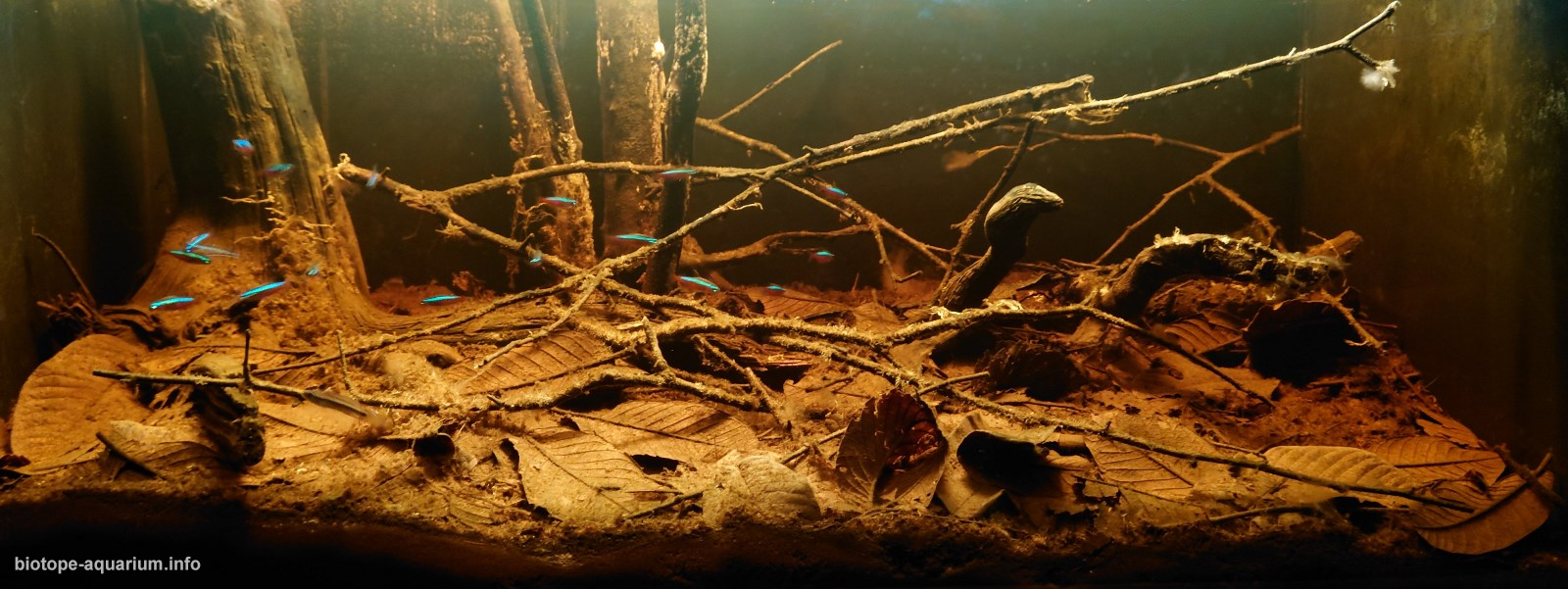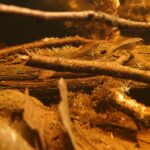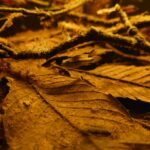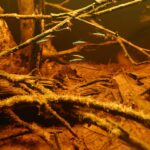The mouth of Igarape Prosperitate

Volume of aquarium: 200 liter
Dimensions of aquarium: 90x50x45 cm
List of fishes: Paracheirodon axelrodi, Taeniacara candidi
Description of Decorations and Substrate: The substrate of the aquarium consists of pond peat bloks, a layer off 8 to 10 cm thick. This is very loose and fish can swim inside the substrate to hide or lay eggs. Two big trunks of driftwood to replicate the tree trunks of the Ficus trees. Braches and twigs I collected from oak trees. Guave leafes are used for the leaf litter layer because they look most like the leafs in the habitat. I only used one type of leaves because almost the entire area consists of Ficus trees.
Description of Equipment: Eheim external pump 2213 with a pump flow of 440l/h. I used a spray bar with more and bigger holes, so the flow rate is lower. Sera siporax and sponge filters.
The aquarium light is a Aquatlantis Easy LED Universal 2.0 Freshwater 549 mm, on a Hight of approximal 50cm above the aquarium.
6800 k (kelvin), 2414 lm, %LEDs: 66,3% Cool White, 17,0% Warm White, 8,2% Blue, 8,5% Red. I’m not using any heaters, the room is constantly heated on 25 – 26°C
Water Parameters: pH 6.5
Conductivity 154
GH 30 mg/l
KH 20 mg/l
Water temperature 24.5 °C
Additional Info: Feeding only once or twice a week. I only added 9 Paracheirodon axelrodi, after a couple months I had 17 of them. Later, I added the 5 Taeniacara candidi and they hunted down every new born after that.
The water in the aquarium is changed every 2 weeks in the amount of 10%.
I always add water of approximately the same temperature.
Aquarium video:
Description of the Area Surrounding the Biotope: The igarapé Prosperitate is a tributary of the lower Rio Preto, a northern affluent of the Rio Negro, Brazil. The igarapé Prosperitate is a typical example of the countless small rain forest creeks of the Rio Negro region. The igarapé is located 12,5 km north-west off its junction with the Rio Negro. The actual stream bed is flanked by broad belts of flood plains, and virtually the entire course is fully shaded by the surrounding vegetation, chiefly Ficus trees. Only the mouth, where during low water the final 30 meters of the forest stream broaden to form a lagoon some 5 meters in width, is exposed to sunlight. Upstream from its broad mouth, the creek splits into two branches. One falls dry during low water, only flowing during periods of normal or high water levels. The other branch maintains a width of 1.5 meters and a depth of 20 to 30 centimeters. The forest encompassing the igarapé Prosperitate consisted of various Ficus trees that measured about 8 meters in height. At the peak of the water height they are submerged up to their crowns, up to about six meters.
Description of the Underwater Landscape of the Biotope: During this period of low water the igarapé mouth measured a maximum depth of 1.2 meters, with no more than 40 cm of water above the layer of leaf litter. All sections of the stream have a substrate of leaf litter several decimeters thick. The upper third of the leaf litter is relatively loose and interspersed with a multitude of branches. The entire watercourse and adjacent areas were scattered with numerous tree stumps.
I replicated the shoreline of the mouth of the igarapé Prosperitate. There are tree trunks submerged and a lot of roots and branches: this is the perfect habitat for the Taeniacara candidi. They hide between the roots and inside the leaf litter layer on the shoreline where the water somtimes is less then 2cm above a thick layer of ficus leafs.
Paracheirodon axelrodi live in large schools above the leaf litter.
Description of the Habitat Parameters: The tea colored water is acidic (pH 4.1 – 5), Gh 2-5°dH, 10-70ys/cm.
Temperatures reach a maximum of 29.5°C. Upstream the water temperature is approximately 24°C, because the complete stream is in shade.
List of Fishes and Invertebrates Occurring in the Nature Biotope: Apistogramma gibbiceps
Apistogramma paucisquamis
Apistogramma pertensis
Apistogramma diplotenia
Dicrossus filamentosus
Dicrossus foirni
Paracheirodon axelrodi
Nannostomus marginatus
Crencichla inpa
Crencichla notopthalmus
Aequidens sp.
Laetacara fulvipinnis
Taeniacara candidi
List of Plants Found in the Nature Biotope: none
Threats to the Ecology of the Biotope: none
Sources of Information:
http://www.apistogramma.com/forum/threads/igarape-prosperitate.6363/
https://www.google.be/url?sa=t&source=web&rct=j&url=http://www.ciclidos-mexico.com/articulos/Dicrossusfoirni-Dicrossus%2520warzeli.pdf&ved=0ahUKEwjh4Lvn1djVAhXLLlAKHSI_B3UQFgiYATAd&usg=AFQjCNHWMokVCmOC_tpPhhP9O1ttumVMZw
https://demo.gbif.org/occurrence/1038271266
https://demo.gbif.org/occurrence/472661029
https://demo.gbif.org/occurrence/207693001
Cichlid atlas volume 1 by uwe romer: Page168-175, Page 122-123, Page 160, Page 652-656, Page 1068-1073





